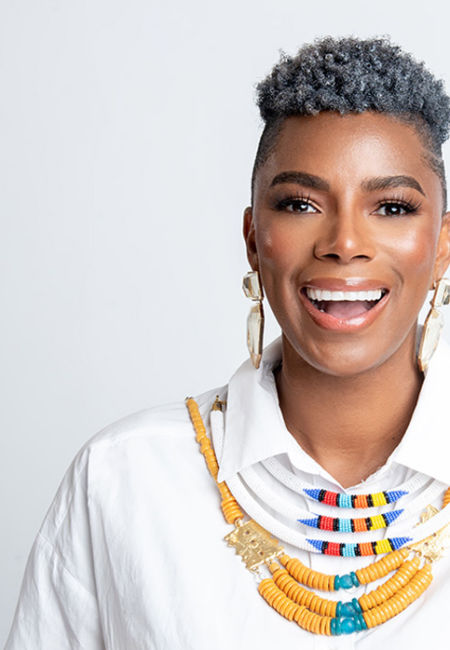By: Stephanie Porfiris, September 18 2021
How to shift away from being a ‘Performative Ally’ and towards a genuine, ongoing partner to the Black community.
Racism is deeply entrenched in our world. It is woven through our educational systems, twisted into social networks, and folded into our cognitive frameworks. It is also, undeniably, in our workplaces and industries – and the tech and innovation ecosystem is no exception.
Wanting to dismantle the systems of white supremacy and anti-Black racism is excellent – but that desire is merely a starting point for the listening, learning, advocating and championing that we, as a predominantly white industry, need to commit to doing every day.
So how do we start?
In an #ElevateLive session three incredible innovators and leaders in diversity and inclusion (D&I) discussed the depth and breadth of systemic racism in the tech & innovation space, and how organizations can make strides towards inclusive leadership.
Among these powerhouse leaders are: Claudette McGowan, Global Executive Officer, Protect Fusion & Cyber Experience at TD and a longstanding champion of diversity in the Canadian tech ecosystem. Karlyn Percil-Mercieca, the CEO of KDPM Consulting Group Inc., an organization that focuses on equity, diversity, inclusion (EDI), and wellness in the workplace. Jodi Kovitz is a long-time advocate for diversity and inclusion, and the advancement of women in technology.
The critical learnings from the session are arranged in alignment with a model Karlyn developed called “L.E.A.P.” It stands for:
Learn, Embody, Act, Prioritize Equity
Step 1: Listen

Photo by Christina @ wocintechchat.com on Unsplash
Systemic racism runs on a network of personal, institutional, and cultural biases. That’s a dangerous web that needs unweaving, and the first step toward disentangling it is intimately understanding every strand.
Get to know the data
“We have the research,” says Karlyn, “Over 66% of Black employees face racism in the workplace, Race Relations Canada rereleased a report…We have had reports and research for years, and nothing is being done.”
Take this opportunity to absorb the data that exists; don’t just read it or skim the headline. Study it. Drink it in. That data is telling critical human stories. Learn it – you’re going to need it for step two.
Surround yourself with all types of people
For Claudette, one of the most significant shifts that an individual can make is to surround themselves with a colour-rich and culturally-diverse social and professional network.
“Who are you spending your time with?” asks Claudette. “Surround yourself with people who can give you context and understanding, because it’s important to spend a lot of time listening and understanding what that experience is.”
And the work doesn’t stop there – the next part is to do what Claudette calls the “internal work.” Ask yourself these questions:
- Why does this lack of equity exist?
- What’s so different about this person’s lived experience?
- What can I personally do to make a difference in this relationship or the community?
- What can I do in this organization?
If you have no exposure to the community, suggests Claudette, you will never add value.
Learn as much as you can (and accept that it will never be enough)
According to Jodi, no matter how much you learn, listen, read, or research, a White person will never understand the lived experience of a Black person. But that doesn’t negate the responsibility to do the difficult work of educating yourself. That process is the first step in millions of tiny steps to create lasting change.
“We have to understand what has happened for many, many, many years to the absolute best of our ability,” says Jodi. “Some people aren’t saying things because they don’t know what to say. And those companies and individuals, like myself, need to listen, listen, listen, before we can do much that’s impactful over the long game.”
Step 2: Embody

Embody all of that data and history that you learned about in the last phase. That includes staring down your white privilege and figuring out what the hell you’re going to do with it.
Stare white privilege and complicity in the face
Addressing systemic racism is not a Black problem. It is a white problem. That doesn’t mean white people have a responsibility to care — it means the issue belongs to white people. The solution will not come from “helping” the Black community – it will come from fixing the monstrously broken, and complicit, white one.
For Karlyn, white people need to understand their own contributions to anti-Black racism, and can start examining it with a simple acronym: SPF. This stands for: Superiority, Privilege, Fragility
To start getting familiar with these elements, white individuals should ask themselves these questions:
- How are the systems embedded in my values?
- How are they embedded in my belief system?
- Do I know my own history?
- What is the belief system I’m bringing into the workplace?
- If senior leadership team looks like you, how are you using your voice?
You’ve confronted your privilege – now leverage it
Once you’ve gotten familiar with your privilege, start using it to demand change. Karlyn says there are 3 main types of white privilege, which she calls the “three Ps”:
- Position Privilege
- Power Privilege
- Pay Privilege
Each of those bolded words above is an opportunity to throw your weight behind justice. Use your position of leadership, your voice (as long as you’re still listening), and your equity to start doing some dismantling.
You just woke up – don’t you dare hit snooze
“Take this really f***king seriously,” says Jodi. “This moment in time, this is a wake-up call for all of us to get very serious about not allowing anti-Black racism in the future of our ecosystem. Every single one of us who does not have the Black lived experience needs to do some very, very hard work. We have to go deep and have courageous conversations about race. It is our responsibility to do that.”
Step 3: Act

By this stage, you’ve done some of the hard work – now it’s time to action it. That’s where the transformation really begins.
Start on your own – and when you’ve earned it, ask for guidance
“Start the conversation, grab a book, start a book club. Talk about it,” says Karlyn. “And after you’ve taken action, ask Black leaders, where is my time probably most effectively spent? Is there a policy you’re trying to move forward? How can I use my voice?”
Focus on policies
According to Karlyn, it’s time we move past research and on to enacting policies, so there’s a shift in the numbers when the next report comes out.
Claudette agrees and sees the shift to remote work has been the perfect opportunity to update hiring policies so that organizations can hire exceptional and diverse candidates by casting a wider net.
“We need to cast wide nets and look for the best and the brightest,” says Claudette, “and one thing we learned is that people can from anywhere. When you’re looking for an engineer, developer, or designer, it doesn’t all have to be in Toronto. It doesn’t all have to be in Canada. We have many opportunities to cast wide nets.”
Start at home
Claudette thinks the best way to start with action is to begin within four walls – your home or your office.
“For every project, we start with our baseline. What does home look like? What does my office look like? Instead of looking at anybody else, let’s start at home first. And, if you’re looking at your organization, do you see the level of inclusivity that reflects the world? Do you see the level of inclusivity that reflects customers?”
If you have failed in the past, own up to it and pay your dues
“Part of systemic racism is the erasure of Black experiences,” explains Karlyn. “[The NFL] put out a statement, yes, they put up some money. Okay. They should have done that regardless, but they still haven’t addressed how [they] treated Colin.”
Starting to address systemic racism starts from wherever you are right now. And not every organization has a perfect past (most don’t). Don’t sweep it under the rug, and don’t be so ashamed of it that you’re afraid to become advocates now. Acknowledge it, repair where possible, and be better.
Commit to change – even if it’s slow
Organizations don’t need to change overnight, but they should make their commitment to change known.
“As part of McKinsey’s 10 actions, they committed over the next four years to double the Black leadership in the workplace,” shares Karlyn. “Even something as simple as that. We’re not saying you have to fix it tonight. But what is your commitment to changing that?”
Step 4: Prioritize Equity

Photo by Glenn Carstens-Peters on Unsplash
The last step, according to Karlyn’s model, is making it a part of everything you do. From the language you choose, to what media you consume, it should be at the centre of your (and your organization’s) decisions.
Make sure you’re addressing the right issues
If your organization has a D&I leader or committee, take the time to assess whether or not they’re addressing the right needs.
Karlyn suggests doing so by executing on the following:
- Look at D&I strategy through the lens of racial justice
- Collect risk-based data within your organization
- Understand the Black experience
- Use a human-centred design that also looks at white complicity
Support Black-owned organizations
“Some of the action that I see is helping out nonprofits. That’s a nice thing. That’s wonderful,” says Claudette, “but we also have for-profit organizations, Amoye Henry and the work that she’s doing on Pitch Better. There’s so many out there where you can lend your support. Not only in time and resources, but in being a customer and helping folks to grow what they’ve pulled together. So I’d love to see people you know, the time, the energy, a little investment can help nonprofit and for-profit Black-owned organizations.”
Consume media mindfully and intentionally
The thing about systemic racism is that it’s not always obvious which structures are reinforcing it. One of those structures is media, so Karlyn posits that being careful about which media you choose to consume is absolutely essential.
You might (and probably will) fail. That’s okay – do your best.
“A lot of us are not getting it right,” says Claudette. “We’re trying our best, and we’re learning.”
“I always appreciate and celebrate a step,” adds Jodi, “because a step is better than no step. And everybody’s on a journey, and there are lots of companies that are taking their first steps now. And hopefully, this is the first step of many, many, many serious steps.”
“I believe everyone is doing their best,” agrees Karlyn. “It’s not a race to perfection. And I expect a lot of messing up as we move forward.”
As continue to wade through the damage that white privilege has inflicted, there will be uncomfortable conversations. There will be embarrassment, regret, and imperfection at the individual and organizational levels – and that’s okay.
The process of dismantling systemic racism will be work and it will be messy – but as an overwhelmingly white ecosystem, it’s our mess to clean up.
Watch the full session below or visit our YouTube channel for more thought-provoking conversations.
Watch the Full Session on YouTube
This article was originally published in September 2021 and updated in February 2022.
Resources
We’ve captured the insights of our panel in a practical, usable guide for members of our community, and we encourage every reader to seek out Karlyn’s primary resources and services at her website.
Article: Race, Racism and Equity: Making Black Lives Matter, Karlyn Percil.
Organization: Black Arts and Innovation Expo
Resource: LEAP Framework, Karlyn Percil
Book recommendation (from Jodi): Me and White Supremacy: Combat Racism, Change the World, and Become a Good Ancestor


